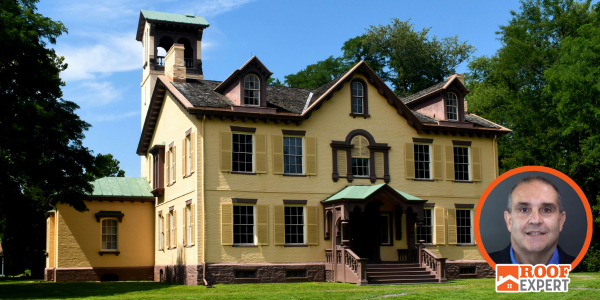Roofing considerations for historic homes
June 3, 2025 at 12:00 p.m.AAR Expert John Kenney says roofing an older or historic home is not just a repair; it's a responsibility.
Replacing or repairing the roof on an older home with historical significance requires more than standard materials and routine installation. These homes come with character, craftsmanship and architectural integrity that must be respected. They may also come with outdated structural elements, unique design features or even regulatory oversight that can complicate a modern re-roofing project. For homeowners, understanding the special considerations involved in roofing historic or aging properties is key to protecting the structure and its legacy.
The first and most crucial step is understanding the historical classification of the property. Suppose the home is designated as a historic property by a local preservation board, state registry or the National Register of Historic Places. In that case, specific rules or guidelines may dictate what kind of roofing material can be used, how it must be installed and whether visible changes to rooflines or details are permitted. In some cases, even replacing the roof with a modern lookalike product may require pre-approval. Homeowners should check with their local historic preservation office before beginning roofing work.
Another critical consideration is the original roofing material and architectural style. Whether the roof was originally slate, cedar shake, clay tile or metal, that material was likely chosen to match the design and era of the home. Preserving that visual authenticity adds value and keeps the home aligned with its historic character. While modern materials may offer similar appearance and improved durability, such as synthetic slate or polymer shake, it's important to carefully weigh aesthetics, performance and compliance.
Older roofs were often built using structural techniques that differ from today's standards. Homes constructed in the 19th or early 20th centuries may have undersized rafters, balloon framing or roof decks made of skip sheathing or plank decking, which can complicate modern material attachment. Before installing a new roof, it's wise to have a structural assessment done by a qualified roofing contractor or engineer to ensure the framing can support the weight of new materials, especially if replacing lightweight shingles with heavier products like slate or tile.
Ventilation and insulation are also key issues in older homes. Many historic houses were built without attic ventilation or with passive systems that don't align with current building codes or energy standards. When replacing the roof, contractors must evaluate how best to add or improve ventilation without compromising the integrity of the structure or appearance of the roof. Options like ridge vents, soffit vents or gable vents should be integrated discreetly and in a way that maintains the historical aesthetic.
Another overlooked factor is flashing and waterproofing, particularly around chimneys, valleys and dormers. These architectural details are often more ornate or complex in older homes, requiring precise, skilled flashing work to prevent leaks. Modern synthetic underlayments and high-performance flashing systems can protect the house more effectively, provided they're installed in a way that honors the home's original detailing.
When repairing or replacing a roof on a historic property, contractors and homeowners alike should also consider long-term durability and maintenance. Historic roofing materials like slate and tile can last well over a century if properly installed and maintained. If only a portion of the roof is damaged, performing selective repairs may be more cost-effective than a complete replacement. Salvaging and reusing original materials where possible preserves the home's authenticity and keeps costs and waste minimal.
Color and finish selection are significant when working on visible, sloped roofs. Modern asphalt shingles may be easy to install, but their appearance can clash with the rest of a historic exterior. Homeowners should opt for colors and textures that reflect the period of the home, even if they choose modern versions of the original material. Many high-quality architectural shingles and metal roofing systems closely mimic the look of heritage products while offering enhanced performance.
Contractors working on these types of projects should have experience with historic restoration or period-specific roofing systems. Hiring someone familiar with the nuances of old construction, specialty materials and preservation guidelines can significantly affect outcomes and compliance. It also ensures the homeowner gets the necessary documentation or inspections if applying for tax credits or grant funding associated with historic preservation.
Finally, communication between the homeowner, contractor and the local preservation board should be open and well-documented if applicable. Any proposed changes should be reviewed to prevent delays or penalties and material samples should be approved when required. Getting everyone aligned early in the process will save time and protect the project's integrity.
Roofing an older or historic home is not just a repair; it's a responsibility. It's about protecting the structure, honoring its design and making wise decisions that blend preservation with performance. By considering historical guidelines, structural limitations, appropriate materials and craftsmanship, homeowners can ensure their new roof is functional, watertight and faithful to the home's unique story.
For those who take the time to approach it carefully, restoring a historic roof is an advantageous investment in heritage and home value.
John Kenney is the CEO of Cotney Consulting Group. Read his full bio here.












Comments
Leave a Reply
Have an account? Login to leave a comment!
Sign In